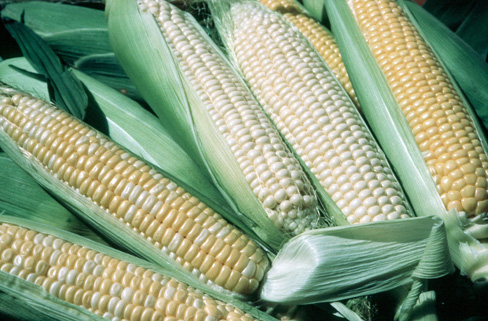Sweet Corn
Sweet corn (Zea mays subsp. mays) is one of the most popular fresh market vegetables produced in Kentucky. While field corn has thousands of years of history, sweet corn has only been available since the 1700s. Present day cultivars vary by kernel color (yellow, white and bicolor) and sugar content.
Marketing
Kentucky producers commonly sell fresh sweet corn through wholesale markets, including local supermarkets and restaurants; farmers markets; and roadside or on-farm stands. Sweet corn can be included as part of a community supported agriculture (CSA) subscription mix. Corn may be an ingredient in value-added products, such as salsa. Fresh sweet corn consumption per person in the U.S. has declined slightly since 2010 and ranged from 7 to 9 pounds annually between 2013 and 2017. Sweet corn consumption overall has declined as less frozen and canned corn is being consumed per person. Because sweet corn is in high demand and in-season sweet corn is easy to sell per ear, it is often used to draw consumers to a retail outlet. Sweet corn is labor-intensive but can be a profitable venture, especially when a reputation for quality is established in a local market. Growers with limited acreage must consider if it is worth the space requirements, however, as it requires more area per unit than many other vegetable crops.
Production

Sweet corn cultivars are grouped according to the gene(s) controlling sugar content level: standard type, super sweet and sugar-enhanced, along with several other types. Any of these may have white, yellow or bicolor kernels. Differences in maturation times (early, mid-season and late) also occur. Roundup Ready varieties, which have tolerance to the herbicide glyphosate, are also available but may not be readily accepted by some clientele. Varieties can be strikingly different in terms of sweetness, eating quality and suitability for mechanical harvest and shipping. Consider carefully which types are best suited for your market situation, as well as your growing conditions. Cultivars with tolerance or resistance to leaf blights and viruses should be selected when planting in June, especially in river bottoms and humid areas of the state. Different types also have different isolation requirements. It is important to isolate plantings of dissimilar cultivars from each other to avoid cross-pollination, which can result in reductions in sugar content and the production of all bicolor corn. All sweet corn varieties will need to be isolated from field corn and popcorn.

